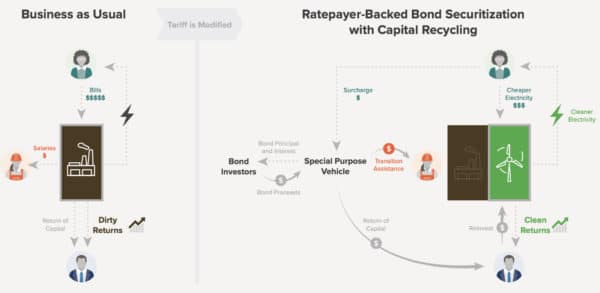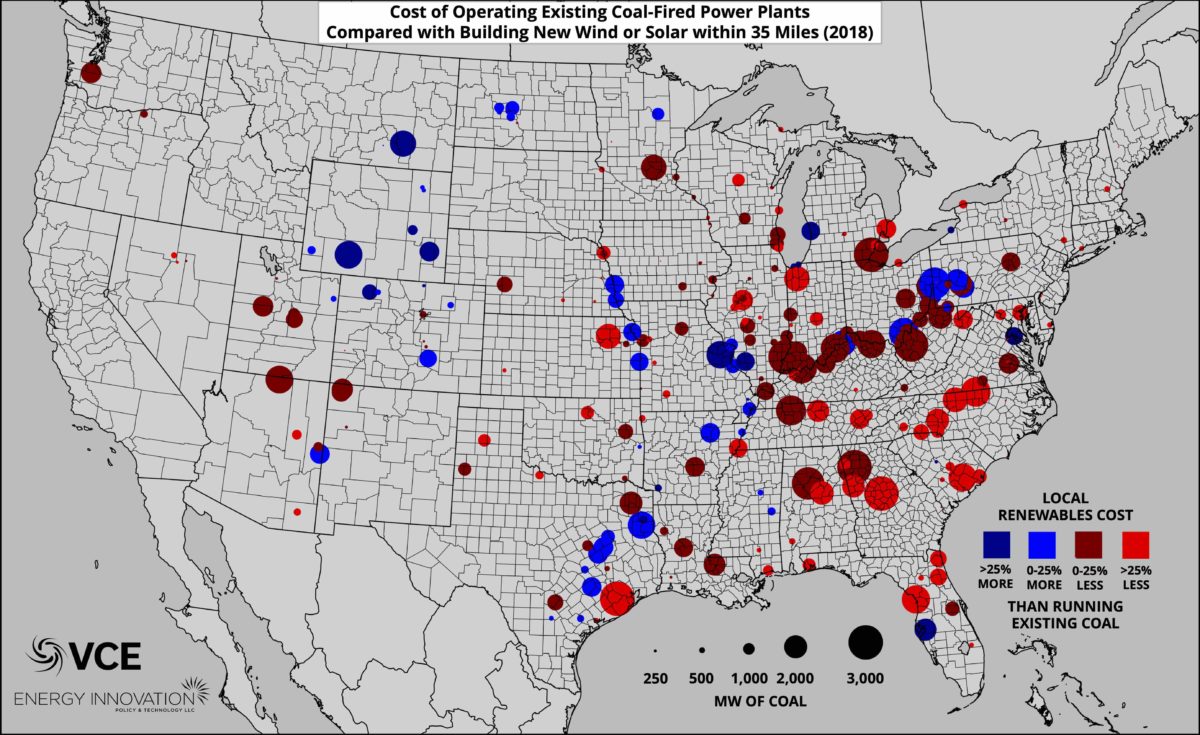Promptly retiring 79% of the nation’s 236 GW of coal units, and replacing them with renewables and storage, would yield savings of $10 billion per year, says a report from the Rocky Mountain Institute, Carbon Tracker and Sierra Club. Retiring all of them now, including units that are not yet uneconomic, would still save $9 billion per year.
The authors recommend federal involvement in financing this transition, and using the savings not only to lower customers’ electric bills but to fund transition assistance for affected workers and communities.
The report updates Energy Innovation’s finding last year that customers would save money if 74% percent of U.S. coal units were replaced with solar and wind power sited nearby; those units are shown in red above. In a related finding, ending uneconomic self-commitment of coal units in the Midwest’s MISO grid region would save customers $350 million per year, the Union of Concerned Scientists found.
The new report defines a coal unit as uneconomic if its operating cost is higher than the combined capital and operating costs of renewables plus storage.
The authors recommend a federal program of loans or loan guarantees to refinance uneconomic coal plants, enabling plant owners to recoup their investment as they shift to renewables. To increase the efficiency of a federal program, the authors recommend a reverse auction “to acquire outstanding debt on coal plants in exchange for closure.” Green banks could also play a role, they say.
A useful model for a federal program, the authors suggest, is New Mexico’s 2019 Energy Transition Act, which achieves all of the authors’ goals at the state level. The law is designed to help New Mexico move to 100% clean energy by 2045.
The report gains added significance from its backing by billionaire Michael Bloomberg, who has partnered before with the Sierra Club. Last year Bloomberg gave $500 million to the Sierra Club for a campaign to substitute renewables for 86 GW of proposed gas units. Bloomberg Philanthropies is the first listed funder of the new study.
Transition assistance
A key benefit of the report is to demystify the process of refinancing coal units—also known as securitization. It provides simple diagrams, showing the parties involved and the flows of money.
While the refinancing model varies depending on whether the coal unit’s owner is a regulated utility or an independent power producer, in each case the model includes a “special purpose vehicle” to hold some of the savings to help with the economic transition of coal economy workers and communities.
For a regulated utility that owns coal units, the authors propose ratepayer-backed bond refinancing, as shown in the image below, prepared by the Rocky Mountain Institute. The image shows customer bills declining as coal is replaced with renewables plus storage, with part of those savings funding the special purpose vehicle. Legislation permitting ratepayer-backed bond refinancing has been passed in six states, the authors say, and introduced in five more.

For an independent power producer (IPP) that sells power using power purchase agreements, the authors suggest that the IPP work with its power off-takers to transition the agreements from coal to renewable power. The IPP could then use the revised agreements to secure financing to build renewables plus storage.
The authors suggest that conducting a stakeholder process in each affected community is the best way to determine how transition funding should be allocated.
2025
The authors conclude that by 2025, assuming that federal tax incentives for renewables and storage have been phased out, a carbon price of $19 per ton of carbon dioxide “would render 90% of the [coal] fleet uncompetitive,” for coal units remaining at that time.
The report is based on an analysis using Carbon Tracker’s Global Coal Power Economics Model, which combines data from several global, national, and regional sources. The report presents similar findings for the European Union, China, and India.
In a side note, the report says no new U.S. coal plants are planned in the next three years, while almost 50 GW of solar and wind projects are “slated as highly probable,” citing Federal Energy Regulatory Commission estimates.
The report is titled “How to retire early: Making accelerated coal phaseout feasible and just.”
This content is protected by copyright and may not be reused. If you want to cooperate with us and would like to reuse some of our content, please contact: editors@pv-magazine.com.








By submitting this form you agree to pv magazine using your data for the purposes of publishing your comment.
Your personal data will only be disclosed or otherwise transmitted to third parties for the purposes of spam filtering or if this is necessary for technical maintenance of the website. Any other transfer to third parties will not take place unless this is justified on the basis of applicable data protection regulations or if pv magazine is legally obliged to do so.
You may revoke this consent at any time with effect for the future, in which case your personal data will be deleted immediately. Otherwise, your data will be deleted if pv magazine has processed your request or the purpose of data storage is fulfilled.
Further information on data privacy can be found in our Data Protection Policy.